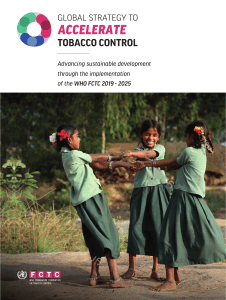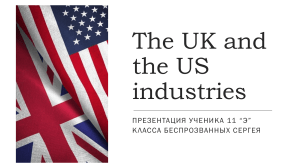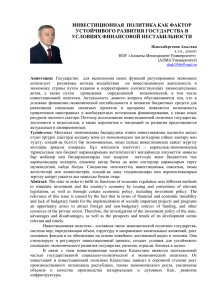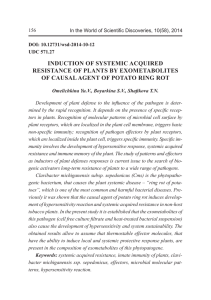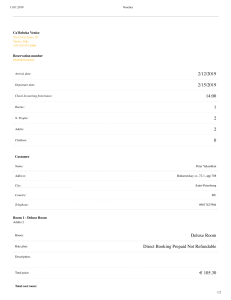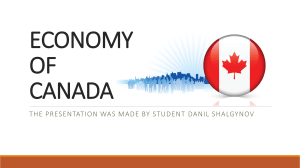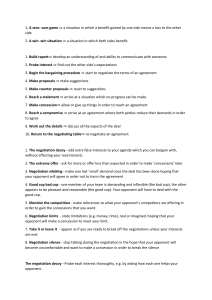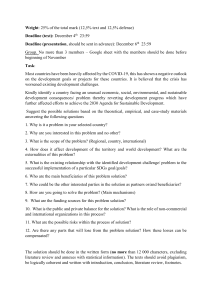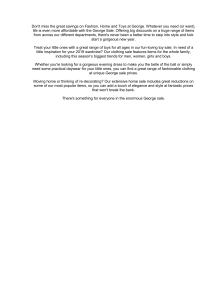
1 Global strategy to accelerate tobacco control: advancing sustainable development through the implementation of the WHO FCTC 2019-2025 WHO/CSF/2019.1 © World Health Organization 2019 Some rights reserved. This work is available under the Creative Commons Attribution-NonCommercial-ShareAlike 3.0 IGO licence (CC BY-NC-SA 3.0 IGO; https://creativecommons.org/licenses/by-nc-sa/3.0/igo). Under the terms of this licence, you may copy, redistribute and adapt the work for non-commercial purposes, provided the work is appropriately cited, as indicated below. In any use of this work, there should be no suggestion that WHO endorses any specific organization, products or services. The use of the WHO logo is not permitted. If you adapt the work, then you must license your work under the same or equivalent Creative Commons licence. If you create a translation of this work, you should add the following disclaimer along with the suggested citation: “ This translation was not created by the World Health Organization (WHO). WHO is not responsible for the content or accuracy of this translation. The original English edition shall be the binding and authentic edition ”. Suggested citation. Global strategy to accelerate tobacco control: advancing sustainable development through the implementation of the WHO FCTC 2019-2025. Geneva: World Health Organization; 2019. Licence: CC BY-NC-SA 3.0 IGO. Any mediation relating to disputes arising under the licence shall be conducted in accordance with the mediation rules of the World Intellectual Property Organization. Cataloguing-in-Publication (CIP) data. CIP data are available at http://apps.who.int/iris. Sales, rights and licensing. To purchase WHO publications, see http://apps.who.int/bookorders. To submit requests for commercial use and queries on rights and licensing, see http://www.who.int/about/licensing. Third-party materials. If you wish to reuse material from this work that is attributed to a third party, such as tables, figures or images, it is your responsibility to determine whether permission is needed for that reuse and to obtain permission from the copyright holder. The risk of claims resulting from infringement of any third-party-owned component in the work rests solely with the user. General disclaimers. The designations employed and the presentation of the material in this publication do not imply the expression of any opinion whatsoever on the part of WHO concerning the legal status of any country, territory, city or area or of its authorities, or concerning the delimitation of its frontiers or boundaries. Dotted and dashed lines on maps represent approximate border lines for which there may not yet be full agreement. The mention of specific companies or of certain manufacturers’ products does not imply that they are endorsed or recommended by WHO in preference to others of a similar nature that are not mentioned. Errors and omissions excepted, the names of proprietary products are distinguished by initial capital letters. All reasonable precautions have been taken by WHO to verify the information contained in this publication. However, the published material is being distributed without warranty of any kind, either expressed or implied. The responsibility for the interpretation and use of the material lies with the reader. In no event shall WHO be liable for damages arising from its use. Advancing sustainable development through the implementation of the WHO FCTC 2019 - 2025 INTRODUCTION A Call For Action T T he Global Strategy to Accelerate Tobacco Control (the Strategy) was developed following a decision of the Parties at the Seventh session of the Conference of the Parties (COP7) to the WHO Framework Convention on Tobacco Control (the Convention or the WHO FCTC). It represents the continued effort to strengthen the operations and implementation of the Convention. There has been progress in implementing the WHO FCTC, but we believe that through the Strategy we can accelerate the implementation of the Convention and its contributions to the 2030 Agenda for Sustainable Development. This Strategy is intended to guide the implementation of the WHO FCTC for the next seven years (2019 – 2025), including the activities/work of the Parties, the Convention Secretariat and other stakeholders, and to serve as the basis for work planning and budgeting for the 2020 – 2021, 2022 – 2023 and the 2024 – 2025 biennia. In addition, the Strategy will inform the agenda and the work of the Conference of the Parties (COP). By reviewing and reflecting on the outcomes of the Strategy, the Parties to the WHO FCTC can continue improving the planning and implementation process through successive cycles. The Strategy is also an important tool to manage increased demands and limited resources while ensuring the effectiveness of the work of the WHO FCTC Convention Secretariat. Tobacco harms o b a cco u s e p o s e s sig n if ic a nt a n d d etr i m e nta l th re at s to h e a lth and well-being and to society at large. Globally, tobacco use leads to a massive loss of life, killing over 7 million people each year. Tobacco use also contributes to the global burden and threat of noncommunicable diseases (NCDs), including cardiovascular diseases, cancers, chronic respiratory diseases and diabetes, among others. Though the health impacts of tobacco use are appalling, the harms of its use go beyond health. The burden of tobacco use poses severe consequences at all levels and sectors of society, from the global, regional and national levels down to the community, family and individual levels. Tobacco use and its promotion constitute serious challenges to sustainable development and undermines social, economic and environmental development around the world. Some of the adverse consequences of tobacco products include: social and economic loss related to tobacco product manufacturing and tobacco use, loss of productivity and income from tobacco-related illness and premature mortality, threats to basic human rights including the right to the highest attainable standard of health, criminality involved in production and trade of illicit tobacco, and the environmental and social effects of tobacco growing including child labour, product use and waste disposal. Moreover, the tobacco industry is recognized as undermining the Parties’ actions in the promotion of public health policies related to the WHO FCTC through the initiation of administrative delays and legal challenges. 4 5 A Global Response To Tobacco Urgent Action Is Needed I W n a globalized world where boundaries between countries are becoming less rigid every day, outcomes in one place can have a global impact. From this perspective, tobacco control is everyone’s business. The good news is that we already know how to tackle the tobacco epidemic. The WHO FCTC is an internationally negotiated, legally binding package of evidence-based measures proven to reduce the harms of tobacco. The WHO FCTC is one of just three international conventions referenced in the United Nations Sustainable Development Goals (SDGs) and their related targets. Target 3.a of the SDGs calls for strengthening implementation of th e WHO FCTC. This Strategy seeks to meaningfully contribute to reaching the overall health goal of SDG 3 and target 3.4 on NCDs. SDG 17 recognizes that the goals can only be realized with a strong commitment to global partnerships and cooperation. The WHO FCTC is also referenced in the 2015 Addis Ababa Action Agenda of the Third International Conference on Financing for Development, which states: “ Price and tax measures on tobacco are recognized as an effective and important means to reduce tobacco use and health care costs and represent a revenue stream for financing development. ” Tobacco control measures have consistently been identified as “ best buys ” for improving global health; delivering large benefits for small investments. Tobacco harms HO FCTC implementation progressed, but is far from complete. As referenced in the 10-year review of the WHO FCTC and Global Progress Reports on Implementation of the WHO FCTC, challenges remain with the slow integration of the WHO FCTC into national law, suboptimal enforcement of existing laws, intensified marketing by the tobacco industry and industry interference with policy-making, inadequate resource allocation for tobacco control, and insufficient human capacity to lead implementation efforts. Furthermore, several articles of the WHO FCTC have had uneven implementation globally. As Parties to the WHO FCTC, we recognize the need to commit to urgent action now to address remaining gaps. Guided by this Strategy, the Parties should take coordinated and focused whole-of-government action to achieve policy coherence domestically and internationally and to remove the barriers globally, regionally and nationally, and across all sectors, that are hindering the full and effective implementation of the commitments included under the WHO FCTC. Through this Strategy, the Parties seek to improve and advance implementation of the WHO FCTC by agreeing on the key priorities for 2019–2025. The Strategy seeks to empower Parties to work multisectorally, with health and non-health sectors and other stakeholders engaged in the fight against tobacco at the global, regional and country levels. It also sets out to elevate the profile and visibility of tobacco control issues, including the Convention itself, internationally and domestically. We know that tobacco use is fully preventable and avoidable. Through concerted effort, the Parties have the opportunity to save millions of lives and to build the conditions necessary for future generations to lead healthier more sustainable lives, free from the harms of tobacco use. 6 7 VISION FRAMEWORK VISION A healthy and sustainable world for all, free of the tobacco epidemic. MISSION To protect present and future generations from the devastating health, social, environmental and economic consequences of tobacco consumption, and exposure to tobacco smoke, through the full and timely implementation of the WHO FCTC. OVERALL TARGET To measure success of this Strategy, we will use the agreed upon voluntary global target of “ a 30% relative reduction in the age-standardized prevalence of current tobacco use in persons aged 15 years and over by 2025 ”. STRATEGIC GOALS GUIDING CONSIDERATIONS In the context of this Strategy, three considerations guide the choice of strategic goals: the impact of measures on tobacco use and tobacco-attributable deaths and diseases; the impact of measures on building cross-sectoral and sustainable countrylevel capacity for tobacco control; and their contribution in advancing the SDGs. 9 Strategic Goal ACCELERATING ACTION Facilitate enhanced implementation of the WHO FCTC by setting clear priorities and by targeting effective means of assistance to where they will be likely to have the greatest impact in reducing tobacco use and harm. 11 Strategic Objective 1.1 Strategic Objective 1.2 Give priority to enabling action to accelerate WHO FCTC implementation, including effective forms of technical and financial assistance to support Parties in the identified priority action areas. Strengthen systems for regularly capturing and sharing lessons and evidence on new, innovative and successful means of implementing tobacco control measures. Specific objectives Specific objectives Parties develop, implement and regularly update comprehensive, costed national tobacco control strategies (WHO FCTC Article 5), focusing on multisectoral and crosscutting policies and Articles most important in the national context. ACCELARATING ACTION 1.1.1. 1.1.2. 1.1.3. 1.2.1. Improve mechanisms for sharing of expertise through South–South and Triangular Cooperation 1.2.2. Strengthen the role of knowledge hubs in assisting the Parties. Indicators Parties implement price and tax measures (Article 6). • Number of Parties that have received assistance from the WHO FCTC knowledge hubs. • Number of Parties involved in South–South and Triangular Cooperation programmes, either as provider or recipient. Parties implement time-bound measures (Articles 8, 11 and 13). Indicators • Number of Parties reporting having received or provided financial and/or technical support. • Number of Parties that have submitted a costed national tobacco control plan as part of their regular WHO FCTC reports. • Number of Parties implementing price and tax measures. • Number of Parties with strengthened national tobacco control measures. • Number of Parties that have identified WHO FCTC implementation as a development priority, including in their United Nations Development Assistance Framework (UNDAF). 12 13 Strategic Goal BUILDING INTERNATIONAL ALLIANCES AND PARTNERSHIPS ACROSS SECTORS AND CIVIL SOCIETY TO CONTRIBUTE TO WHO FCTC IMPLEMENTATION Globally and at the country level, raise the profile and visibility of the WHO FCTC as a response to the threat of tobacco to economic and social development and to the environment. Forge partnerships with a wide range of sectors with a view to confronting tobacco-related harms and the tobacco industry and fostering policy coherence across sectors, internationally and nationally. 15 Strategic Objective 2.1 Mobilize international, intergovernmental and developmental partners to integrate the WHO FCTC into their work, and/or their SDG responses, by developing partnerships and joint strategies with United Nations and global agencies and initiatives that have a clear mandate for reducing wider tobacco-related harms, or who have an ability: a) to raise the profile and visibility of the WHO FCTC; and b) to influence and stimulate tobacco control action at the regional and national levels. BUILDING PARTNERSHIPS Specific objectives 2.1.1. Establish stronger alignment between, and cooperation with, the World Health Organization (WHO), agencies within the United Nations System and other relevant international agencies and initiatives. • Number of Parties where WHO country offices included WHO FCTC implementation in the country cooperation strategies. • Number of Parties that include WHO FCTC implementation in their voluntary reports on their domestic implementation of the SDGs, in relation to target 3.a. Strategic Objective 2.2 Catalyze and leverage the contributions of external stakeholders, particularly civil society, to achieve the aims of the Convention. Specific objectives 2.2.1. 2.1.2. 2.1.3. Ensure that the WHO FCTC is fully mainstreamed in the implementation of the 2030 Sustainable Development Agenda and deliberations in any relevant forum organized under the United Nations umbrella that are relevant to the WHO FCTC. Develop mutually reinforcing approaches to implementing the Global Action Plan for the Prevention and Control of Noncommunicable Diseases 2013–2020 through cooperation with members of the United Nations Inter-agency Task Force on Noncommunicable Diseases, the Global Coordination Mechanism for NCDs and other relevant initiatives. 2.1.4. Foster partnerships with government or intergovernmental organizations and institutions. 2.1.5. • 2.2.2. Establish and operate a Coordination Platform in accordance with recommendations provided by the Working Group on Sustainable Measures (FCTC/COP/7/18). 2.2.3. Promote research that is relevant to WHO FCTC implementation, in particular priorities set out in the Strategy, in accordance with Article 20. Indicators • Number of Parties that include civil society participation in the development and implementation of national tobacco control approaches. • Number of nongovernmental organizations that are accredited as Observers to the Conference of the Parties participating in COP sessions. • Financial and technical support from civil society organizations to advance FCTC implementation. Develop a communications plan on the Strategy to also raise the profile and visibility of the Convention. Indicators Number of development agencies, intergovernmental organizations, international organizations or initiatives that include WHO FCTC implementation in their strategies or plans. 16 Enhance civil society participation including through the adoption of best practices of other United Nations organizations, taking into consideration WHO FCTC Article 5.3. 17 Strategic Goal PROTECTING THE INTEGRITY AND BUILDING ON THE ACHIEVEMENTS UNDER THE WHO FCTC Overcoming barriers to the full, effective and sustainable implementation of the WHO FCTC and wider tobacco control efforts. 18 19 Strategic Objective 3.1 Strategic Objective 3.2 Improve the governance and administrative mechanisms of the WHO FCTC to ensure that all WHO FCTC related activities undertaken are prioritized, effective and sustainable, and insulated from any influence by the tobacco industry. Support and encourage Parties in their efforts to remove barriers to country-level tobacco control efforts. PROTECTING INTEGRITY Specific objectives 3.1.1. Align the agendas, workplans and budgets of the COP with the Strategy. 3.1.2. By 2020, create a peer-led WHO FCTC Implementation Review Mechanism to facilitate addressing gaps and challenges of individual Parties, share lessons learnt and contribute to the implementation of this Strategy. 3.1.3. Protect COP and other WHO FCTC activities from the commercial and other vested interests of the tobacco industry. 3.2.1. Build political support for tobacco control efforts. 3.2.2. Promote multisectoral collaborative efforts, including increased collaboration with civil society organizations. 3.2.3. Mobilize sustainable resources for tobacco control. 3.2.4. Implement measures to protect public health policy from interference by the tobacco industry (Article 5.3) and continuously monitor tobacco industry activities at national and international levels. 3.2.5. Monitor policy and programme progress of the key WHO FCTC provisions including estimation of lives saved, costs averted and other improved health and economic outcomes. Indicators • An Implementation Review Mechanism has been established. • Workplans and budget of the WHO FCTC Convention Secretariat align with the Strategy. • Specific objectives Indicators • Number of Parties that reported implementation of any measures relating to Article 5.3. • Number of Parties having an operational national multisectoral coordinating mechanism for tobacco control. • Number of Parties that reported tobacco industry interference as the main barrier to WHO FCTC implementation. • Number of Parties that fully fund their costed national tobacco control plans or strategies. An indicator that measures the gap in global funding for WHO FCTC implementation to be developed. 20 21 The successive workplans and budgets of the WHO FCTC Convention Secretariat, adopted biennially by the COP, will be reoriented in line with the following Operational Objectives, in support of the effective implementation of the Strategic Goals and Objectives of this Strategy. Operational Objective 1. Sustainable Funding Manage the finances of the Convention to maximize its efficiency and effectiveness and find new revenue streams to support WHO FCTC implementation activities. PART 3 OPERATIONAL OBJECTIVES Operational Objective 2. Operational effectiveness Promote optimal operation of the COP and the capacity and ability of the Convention Secretariat to provide support to the COP and to the Parties in their implementation, monitoring and reporting work. Specific objectives 2.1. The Convention Secretariat will review and adjust staffing and management capabilities to support implementation of the Strategy in support of the workplan and budget approved by the COP, in the spirit of Article 5.3 of the WHO FCTC and its Guidelines. 2.2. The Secretariat will apply the principles of prioritization, effectiveness, cost-effectiveness, transparency and accountability to all aspects of its work programme design and implementation, recognizing the finite resources available for core functions of the Secretariat. 2.3. The Secretariat will provide biennial reports to the COP on implementation of the Strategy, including proposed corrective actions. Specific objectives 1.1. Mindful of the cooperation obligations under Articles 22 and 26 of the Convention, the Parties and the Convention Secretariat will mobilize additional technical and financial resources. This may include the creation and implementation of targeted resource mobilization strategies and new or innovative domestic and inter-national funding mechanisms, in accordance with Decision FCTC/COP7/25, to promote the implementation of the WHO FCTC and this Strategy. 1.2. The Convention Secretariat will provide Parties with targeted assistance to develop and implement costed national plans for tobacco control. 1.3. The Convention Secretariat will propose workplans and will conduct resultsbased budgeting that are based on the Strategy. 1.4. The Convention Secretariat should establish and maintain WHO FCTC Goodwill Ambassadors, taking into account Article 5.3 of the WHO FCTC and best practices relating to the avoidance of conflicts of interest. 22 23 Secretariat of the WHO Framework Convention on Tobacco Control Hosted by: World Health Organization Avenue Appia 20, 1211 Geneva 27, Switzerland Tel: +41 22 791 50 43 Fax: +41 22 791 58 30 Mail: fctcsecretariat@who.int Web: www.who.int/fctc
